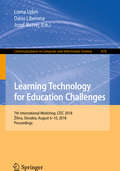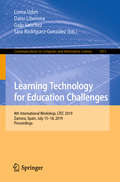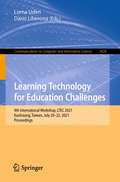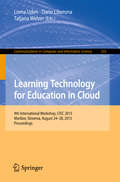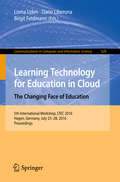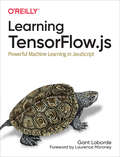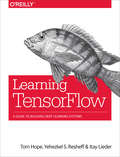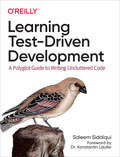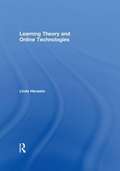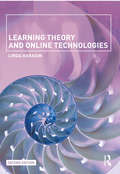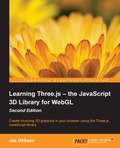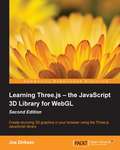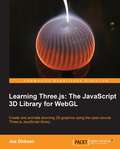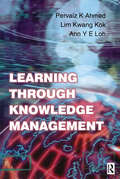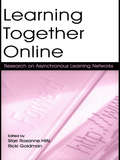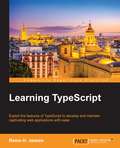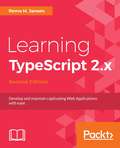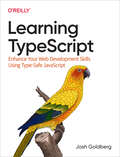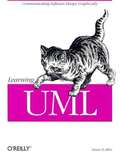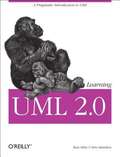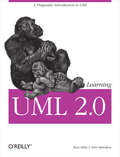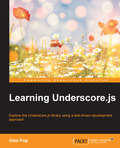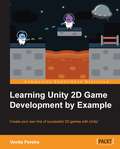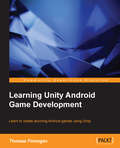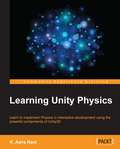- Table View
- List View
Learning Technology for Education Challenges: 7th International Workshop, LTEC 2018, Žilina, Slovakia, August 6–10, 2018, Proceedings (Communications in Computer and Information Science #870)
by Lorna Uden Dario Liberona Jozef RistvejThis book constitutes the refereed proceedings of the 7th International Workshop on Learning Technology for Education Challenges, LTEC 2018, held in Žilina, Slovakia, in August 2018. The 25 revised full papers presented were carefully reviewed and selected from 54 submissions. The papers are organized in the following topical sections: Gamification and learning; learning and knowledge transfer; learning technologies applications; virtual learning environments; and mobile learning and MOOCs. LTEC 2018 examines how these technologies and pedagogical advances can be used to change the way teachers teach and students learn, while giving special emphasis to the pedagogically effective ways we can harness these new technologies in education.
Learning Technology for Education Challenges: 8th International Workshop, LTEC 2019, Zamora, Spain, July 15–18, 2019, Proceedings (Communications in Computer and Information Science #1011)
by Lorna Uden Dario Liberona Galo Sanchez Sara Rodríguez-GonzálezThis book constitutes the refereed proceedings of the 8th International Workshop on Learning Technology for Education Challenges, LTEC 2019, held in Zamora, Spain, in July 2019.The 41 revised full papers presented were carefully reviewed and selected from 83 submissions. The papers are organized in the following topical sections: learning technolgies; learning tools and environment; e-learning and MOOCs; learning practices; social media learning tools; machine learning and evaluation support programs. LTEC 2019 examines how these technologies and pedagogical advances can be used to change the way teachers teach and students learn, while giving special emphasis to the pedagogically effective ways we can harness these new technologies in education.
Learning Technology for Education Challenges: 9th International Workshop, LTEC 2021, Kaohsiung, Taiwan, July 20-22, 2021, Proceedings (Communications in Computer and Information Science #1428)
by Lorna Uden Dario LiberonaThis book constitutes the refereed proceedings of the 9th International Workshop on Learning Technology for Education Challenges, LTEC 2021, held in Kaohsiung, Taiwan, in July 2021. The 11 revised full papers and 6 short papers presented were carefully reviewed and selected from 83 submissions. The papers are organized in the following topical sections: learning tools and environment; e-learning and transferability strategies; serious games technologies; learning practices and knowledge transfer.
Learning Technology for Education in Cloud
by Lorna Uden Dario Liberona Tatjana WelzerThis book constitutes the refereed proceedings of the Fourth International Workshop on Learning Technology for Education in Cloud, LTEC 2015, held in Maribor, Slovenia, in August 2015. The 24 revised full papers presented were carefully reviewed and selected from 46 submissions. The papers cover various aspects of technologies for learning, such as MOOC challenges; cooperative learning; learning engineering; learning tools and environments; STEM.
Learning Technology for Education in Cloud - The Changing Face of Education
by Lorna Uden Dario Liberona Birgit FeldmannThis book constitutes the refereed proceedings of the 5th International Workshop on Learning Technology for Education in Cloud, LTEC 2016, held in Maribor, Slovenia, in July 2016. The 25 revised full papers presented were carefully reviewed and selected from 51 submissions. The papers are organized in topical sections on learning technologies; learning tools and environment; MOOC for learning; problem solving and knowledge transfer; case study.
Learning TensorFlow.js: Powerful Machine Learning In Javascript
by Gant LabordeGiven the demand for AI and the ubiquity of JavaScript, TensorFlow.js was inevitable. With this Google framework, seasoned AI veterans and web developers alike can help propel the future of AI-driven websites. In this guide, author Gant Laborde (Google Developer Expert in machine learning and the web) provides a hands-on end-to-end approach to TensorFlow.js fundamentals for a broad technical audience that includes data scientists, engineers, web developers, students, and researchers.You'll begin by working through some basic examples in TensorFlow.js before diving deeper into neural network architectures, DataFrames, TensorFlow Hub, model conversion, transfer learning, and more. Once you finish this book, you'll know how to build and deploy production-readydeep learning systems with TensorFlow.js.Explore tensors, the most fundamental structure of machine learningConvert data into tensors and back with a real-world exampleCombine AI with the web using TensorFlow.jsUse resources to convert, train, and manage machine learning dataBuild and train your own training models from scratch
Learning TensorFlow: A Guide to Building Deep Learning Systems
by Itay Lieder Tom Hope Yehezkel S. ResheffRoughly inspired by the human brain, deep neural networks trained with large amounts of data can solve complex tasks with unprecedented accuracy. This practical book provides an end-to-end guide to TensorFlow, the leading open source software library that helps you build and train neural networks for computer vision, natural language processing (NLP), speech recognition, and general predictive analytics.Authors Tom Hope, Yehezkel Resheff, and Itay Lieder provide a hands-on approach to TensorFlow fundamentals for a broad technical audience—from data scientists and engineers to students and researchers. You’ll begin by working through some basic examples in TensorFlow before diving deeper into topics such as neural network architectures, TensorBoard visualization, TensorFlow abstraction libraries, and multithreaded input pipelines. Once you finish this book, you’ll know how to build and deploy production-ready deep learning systems in TensorFlow.Get up and running with TensorFlow, rapidly and painlesslyLearn how to use TensorFlow to build deep learning models from the ground upTrain popular deep learning models for computer vision and NLPUse extensive abstraction libraries to make development easier and fasterLearn how to scale TensorFlow, and use clusters to distribute model trainingDeploy TensorFlow in a production setting
Learning Test-Driven Development: A Polyglot Guide to Writing Uncluttered Code
by Saleem SiddiquiYour code is a testament to your skills as a developer. No matter what language you use, code should be clean, elegant, and uncluttered. By using test-driven development (TDD), you'll write code that's easy to understand, retains its elegance, and works for months, even years, to come. With this indispensable guide, you'll learn how to use TDD with three different languages: Go, JavaScript, and Python.Author Saleem Siddiqui shows you how to tackle domain complexity using a unit test-driven approach. TDD partitions requirements into small, implementable features, enabling you to solve problems irrespective of the languages and frameworks you use. With Learning Test-Driven Development at your side, you'll learn how to incorporate TDD into your regular coding practice.This book helps you:Use TDD's divide-and-conquer approach to tame domain complexityUnderstand how TDD works across languages, testing frameworks, and domain conceptsLearn how TDD enables continuous integrationSupport refactoring and redesign with TDDLearn how to write a simple and effective unit test harness in JavaScriptSet up a continuous integration environment with the unit tests produced during TDDWrite clean, uncluttered code using TDD in Go, JavaScript, and Python
Learning Theory and Online Technologies
by Linda HarasimLearning Theory and Online Technologies offers a powerful overview of the current state of elearning, a foundation of its historical roots and growth, and a framework for distinguishing among the major approaches to elearning. It effectively addresses pedagogy (how to design an effective online environment for learning), evaluation (how to know that students are learning), and history (how past research can guide successful online teaching and learning outcomes). An ideal textbook for undergraduate education and communication programs, and Educational Technology Masters, PhD, and Certificate programs, readers will find Learning Theory and Online Technologies provides a synthesis of the key advances in elearning theory, the key frameworks of research, and clearly links theory and research to successful learning practice.
Learning Theory and Online Technologies
by Linda HarasimLearning Theory and Online Technologies offers a powerful overview of the current state of online learning, the foundations of its historical roots and growth, and a framework for distinguishing between the major approaches to online learning. It addresses pedagogy (how to design an effective online environment for learning), evaluation (how to know that students are learning), and history (how past research can guide successful online teaching and learning outcomes). An ideal textbook for undergraduate Education and Communication programs as well as Educational Technology Masters, Ph.D., and Certificate programs, Learning Theory and Online Technologies provides a synthesis of the key advances in online education learning theory and the key frameworks of research, and clearly links theory and research to successful learning practice. This revised second edition updates data on digital media adoption globally, adds a new chapter on connectivism as a learning theory, and updates the chapter on online collaborative learning, renaming the theory as collaborativism and considering the challenges that arise with the growth of artificial intelligence.
Learning Three.js – the JavaScript 3D Library for WebGL - Second Edition
by Jos DirksenIf you know JavaScript and want to start creating 3D graphics that run in any browser, this book is a great choice for you. You don't need to know anything about math or WebGL; all that you need is general knowledge of JavaScript and HTML.
Learning Three.js – the JavaScript 3D Library for WebGL Second Edition
by Jos Dirksen<P><P>Create stunning 3D graphics in your browser using the Three.js JavaScript library <P><P>About This Book <P><P>Enhance your 3D graphics with light sources, shadows, advanced materials, and textures <P><P>Load models from external sources, and visualize and animate them directly from JavaScript <P><P>Each subject is explained using extensive examples that you can use directly and adapt for your own purposes <P><P>Who This Book Is For <P><P>If you know JavaScript and want to start creating 3D graphics that run in any browser, this book is a great choice for you. You don't need to know anything about math or WebGL; all that you need is general knowledge of JavaScript and HTML. <P><P>What You Will Learn <P><P>Use the different geometries that are provided by Three.js <P><P>Apply realistic lighting and shadows to the 3D objects you have created <P><P>Use the different camera controls provided by Three.js to effortlessly navigate around your 3D scene <P><P>Make use of advanced textures on materials to create realistic-looking 3D objects by using bump maps, normal maps, specular maps, and light maps <P><P>Import and animate models from external formats, such as OBJ, STL, Collada, and many more <P><P>Create and run animations using morph targets and bone animations <P><P>Explore the Physijs JavaScript library to apply physics to your 3D objects <P><P>Interact directly with WebGL by creating custom vertex and fragment shaders
Learning Three.js: The JavaScript 3D Library for WebGL
by Jos Dirksen"Learning Three.js is a hands-on guide which provides everything you need to start working with the powerful JavaScript library, and start creating awesome in-browser visualizations".Learning Three.js is written for anyone looking to get started with Three.js, or looking to improve their skills with the popular js library. The book assumes some knowledge of javascript, but you don't need any knowledge of Three.js itself to follow the book.
Learning Through Knowledge Management
by Pervaiz K. Ahmed Kwang Kok Lim Ann Y Loh'Learning through Knowledge Management' provides an insightful overview of the main issues integrating learning and Knowledge Management. It offers a rich resource of case examples that highlight Knowledge Management in practice. The text explores and defines learning and Knowledge Management concepts, and deals with the elements that play an important part in determining implementation success in the organization. The chapters present a managerially oriented discussion of the following key areas:* The role of processes in managing knowledge* The behavioural side of Knowledge Management * Leadership reflexes for knowledge management success* The key features of Information Technology required for Knowledge Management* The future of Knowledge Management as part of organization management.There are many case studies which include: British Airways BP Amoco Ford Hewlett Packard Xerox Swedish Police IBM The case studies encompass a diverse and broad range of sectors, maturity of practice, problems and approaches to Knowledge Management.
Learning Together Online: Research on Asynchronous Learning Networks
by Starr Roxanne Hiltz Ricki GoldmanThis book is about the past and future of research on the effectiveness of learning networks (also known as "e-learning" or "online learning" or "Web-based learning"). Learning networks are groups of people using computer technology, communicating and collaborating online to build knowledge together. Over the past decade there has been an explosion not only of online courses, but also of studies on them. In Learning Together Online: Research on Asynchronous Learning Networks, leading researchers in the field use an integrated theoretical framework, which they call "Online Interaction Learning Theory," to organize what past research shows and where future research is going. It models the variables and processes that are important in determining the relative effectiveness of online learners working to reach a deeper level of understanding by interacting with each other and with the texts under investigation. Now that there have been hundreds of studies and thousands of courses offered online, what does the empirical evidence show? This book addresses the question directly by presenting what is known from research results about how to design and teach courses effectively online, ranging from the organizational context and characteristics of students to learning theories and research design methods. It also provides a research agenda for the next decade. Learning Together Online: Research on Asynchronous Learning Networks is both a textbook for graduate students and a professional reference for faculty teaching online, researchers conducting studies, and graduate students taking courses about learning technologies who need to know the state of the art of research in the area of online learning.
Learning TypeScript
by Remo H. JansenExploit the features of TypeScript to develop and maintain captivating web applications with ease About This Book * Learn how to develop modular, scalable, maintainable, and adaptable web applications by taking advantage of TypeScript * Create object-oriented JavaScript that adheres to the solid principles efficiently * A comprehensive guide that explains the fundamentals of TypeScript with the help of practical examples Who This Book Is For If you are a JavaScript developer aiming to learn TypeScript to build beautiful web applications, then this book is for you. No prior knowledge of TypeScript is required. What You Will Learn * Learn the key TypeScript language features and language runtime * Develop modular, scalable, maintainable, and adaptable web applications * Create object-oriented code that adheres to the solid principles * Save time using automation tools like Gulp and Karma * Develop robust applications with testing (Mocha, Chai and SinonJS) * Put your TypeScript skills in practice by developing a single-page web application framework from scratch * Use the JavaScript of tomorrow (ES6 and ES7) today with TypeScript In Detail TypeScript is an open source and cross-platform typed superset of JavaScript that compiles to plain JavaScript that runs in any browser or any host. It allows developers to use the future versions of JavaScript (ECMAScript 6 and 7) today. TypeScript adds optional static types, classes, and modules to JavaScript, to enable great tooling and better structuring of large JavaScript applications. This book is a step-by-step guide that will get you started with TypeScript with the help of practical examples. You start off by understanding the basics of TypeScript. Next, automation tools like Grunt are explained followed by a detailed description of function, generics, callbacks and promises. After this, object-oriented features and the memory management functionality of TypeScript are explained. At the end of this book, you will have learned enough to implement all the concepts and build a single page application from scratch. Style and approach This is a step-by-step guide that covers the fundamentals of TypeScript with practical examples. Each chapter introduces a set of TypeScript language features and leads the readers toward the development of a real-world application.
Learning TypeScript 2.x: Develop and maintain captivating web applications with ease, 2nd Edition
by Remo H. JansenExploit the features of TypeScript to easily create your very own web applicationsKey Features Develop modular, scalable, maintainable, and adaptable web applications by taking advantage of TypeScript Walk through the fundamentals of TypeScript with the help of practical examples Enhance your web development skills using TypeScript 2.xBook DescriptionTypeScript is an open source and cross-platform statically typed superset of JavaScript that compiles to plain JavaScript and runs in any browser or host. This book is a step-by-step guide that will take you through the use and benefits of TypeScript with the help of practical examples. You will start off by understanding the basics as well as the new features of TypeScript 2.x. Then, you will learn how to work with functions and asynchronous programming APIs. You will continue by learning how to resolve runtime issues and how to implement TypeScript applications using the Object-oriented programming (OOP) and functional programming (FP) paradigms. Later, you will automate your development workflow with the help of tools such as Webpack. Towards the end of this book, you will delve into some real-world scenarios by implementing some full-stack TypeScript applications with Node.js, React and Angular as well as how to optimize and test them. Finally, you will be introduced to the internal APIs of the TypeScript compiler, and you will learn how to create custom code analysis tools.What you will learn Understand TypeScript in depth, including its runtime and advanced type system features Master the core principles of the object-oriented programming and functional programming paradigms with TypeScript Save time using automation tools such as Gulp, Webpack, ts-node, and npm scripts Develop robust, modular, scalable, maintainable, and adaptable applications with testing frameworks such as Mocha, Chai, and Sinon.JS Put your TypeScript skills to practice by developing full-stack web applications with Node.js, React and Angular Use the APIs of the TypeScript compiler to build custom code analysis toolWho this book is forIf you are a developer aiming to learn TypeScript to build attractive web applications, this book is for you. No prior knowledge of TypeScript is required. However, a basic understanding of JavaScript would be an added advantage.
Learning TypeScript: Enhance Your Web Development Skills Using Type-Safe JavaScript
by Josh GoldbergTypeScript has conquered the world of JavaScript. Identified in developer surveys as one of the world's fastest growing and most popular languages, TypeScript is widely used in consumer and business companies across the world and is frequently credited for helping massive web applications scale. But what exactly is TypeScript? How and why does it work, and how can we use it?This practical book takes beginner and advanced JavaScript programmers alike from knowing nothing about "types" or "type systems" to full mastery of TypeScript fundamentals.You'll learn:Benefits of TypeScript and general characteristics of its type systemWhy and how TypeScript is useful on top of "vanilla" JavaScriptHow to inform your type system by using development-only type annotationsHow TypeScript analyzes and understands code to help you augment your existing development patternsHow TypeScript helps you work with arrays, classes, functions, objects, and other important built-in JavaScript constructsHow to effectively use the plethora of TypeScript configuration options to tailor the TypeScript compiler to your teams and projectsA variety of IDE integrations such as automated refactors and intelligent code searches provided by TypeScript to help you develop quickly with fewer bugs
Learning UML
by Sinan Si AlhirLearning UML introduces the Unified Modeling Language and leads you through an orderly progress towards mastery of the language. Throughout this book, author Sinan Si Alhir maintains a clear focus on UML the language and avoids getting caught up in the cobwebs of methodology. His presentation is direct and to-the-point. Each chapter ends with a set of exercises that you can use to test your growing knowledge of UML and its concepts.
Learning UML 2.0
by Russell Miles Kim Hamilton"Since its original introduction in 1997, the Unified Modeling Language has revolutionized software development. Every integrated software development environment in the world--open-source, standards-based, and proprietary--now supports UML and, more importantly, the model-driven approach to software development. This makes learning the newest UML standard, UML 2.0, critical for all software developers--and there isn't a better choice than this clear, step-by-step guide to learning the language." --Richard Mark Soley, Chairman and CEO, OMG If you're like most software developers, you're building systems that are increasingly complex. Whether you're creating a desktop application or an enterprise system, complexity is the big hairy monster you must manage. The Unified Modeling Language (UML) helps you manage this complexity. Whether you're looking to use UML as a blueprint language, a sketch tool, or as a programming language, this book will give you the need-to-know information on how to apply UML to your project. While there are plenty of books available that describe UML, Learning UML 2.0 will show you how to use it. Topics covered include: Capturing your system's requirements in your model to help you ensure that your designs meet your users' needs Modeling the parts of your system and their relationships Modeling how the parts of your system work together to meet your system's requirements Modeling how your system moves into the real world, capturing how your system will be deployed Engaging and accessible, this book shows you how to use UML to craft and communicate your project's design. Russ Miles and Kim Hamilton have written a pragmatic introduction to UML based on hard-earned practice, not theory. Regardless of the software process or methodology you use, this book is the one source you need to get up and running with UML 2.0. Additional information including exercises can be found at www.learninguml2.com . Russ Miles is a software engineer for General Dynamics UK, where he works with Java and Distributed Systems, although his passion at the moment is Aspect Orientation and, in particular, AspectJ. Kim Hamilton is a senior software engineer at Northrop Grumman, where she's designed and implemented a variety of systems including web applications and distributed systems, with frequent detours into algorithms development.
Learning UML 2.0: A Pragmatic Introduction to UML
by Kim Hamilton Russ Miles"Since its original introduction in 1997, the Unified Modeling Language has revolutionized software development. Every integrated software development environment in the world--open-source, standards-based, and proprietary--now supports UML and, more importantly, the model-driven approach to software development. This makes learning the newest UML standard, UML 2.0, critical for all software developers--and there isn't a better choice than this clear, step-by-step guide to learning the language."--Richard Mark Soley, Chairman and CEO, OMG If you're like most software developers, you're building systems that are increasingly complex. Whether you're creating a desktop application or an enterprise system, complexity is the big hairy monster you must manage.The Unified Modeling Language (UML) helps you manage this complexity. Whether you're looking to use UML as a blueprint language, a sketch tool, or as a programming language, this book will give you the need-to-know information on how to apply UML to your project. While there are plenty of books available that describe UML, Learning UML 2.0 will show you how to use it. Topics covered include:Capturing your system's requirements in your model to help you ensure that your designs meet your users' needsModeling the parts of your system and their relationshipsModeling how the parts of your system work together to meet your system's requirementsModeling how your system moves into the real world, capturing how your system will be deployedEngaging and accessible, this book shows you how to use UML to craft and communicate your project's design. Russ Miles and Kim Hamilton have written a pragmatic introduction to UML based on hard-earned practice, not theory. Regardless of the software process or methodology you use, this book is the one source you need to get up and running with UML 2.0. Additional information including exercises can be found at www.learninguml2.com.Russ Miles is a software engineer for General Dynamics UK, where he works with Java and Distributed Systems, although his passion at the moment is Aspect Orientation and, in particular, AspectJ. Kim Hamilton is a senior software engineer at Northrop Grumman, where she's designed and implemented a variety of systems including web applications and distributed systems, with frequent detours into algorithms development.
Learning Underscore.js
by Alex PopExplore the Underscore.js library by example using a test-driven development approachAbout This BookUnderstand and learn to apply functional programming principles using the built-in functions of Underscore.jsLeverage and reuse Underscore.js-based code to create code that targets client, server, or database contextsTake Underscore.js further by reusing code between client and server and by learning about other closely related librariesWho This Book Is ForIf you are a developer with fundamental JavaScript knowledge and want to use modern JavaScript libraries to extend your functional programming skills, then Underscore.js is an important library you should be familiar with.What You Will LearnReference and call Underscore.js functions using a modern JavaScript development workflowApply Underscore.js to JavaScript arrays, objects, and functionsTake advantage of object-oriented or functional programming techniques with Underscore.jsLeverage Underscore.js to create code that targets client, server, or database contextsExtend Underscore.js functionality with other closely related librariesReuse Underscore.js-based code between client and server applicationsPrepare for the upcoming JavaScript standard ECMAScript 6 and support older browsersIn DetailUnderscore.js is one of the most popular modern JavaScript libraries used for functional programming. It can be used as a base for building complex JavaScript applications in a sustainable manner and for building other JavaScript libraries. It embraces functional programming principles but is not opinionated and can be used with imperative, object-oriented, functional, or other programming styles.This book explores how to use Underscore.js to power your code and understand modern JavaScript development concepts while applying a lightweight and efficient workflow to build applications.The book starts with an incremental Underscore.js introduction by exploring key JavaScript concepts. You will then explore the basic features of Underscore.js in action and establish a lightweight development workflow that allows the provided examples to be guided by tests. The book then covers the functionality of Underscore.js with in-depth examples and explanations for understanding and applying the Underscore.js API. You'll also learn how to use Underscore.js as a base for your own modules and libraries within an object-oriented or functional programming style, and will be able to explore Underscore.js use cases in different environments.Eventually, you'll learn about libraries that are closely related with Underscore.js, how to share code between client and server, and how to prepare for the upcoming JavaScript standard ECMAScript 6.Style and approachThis book takes an example-driven approach to describing some of the essential JavaScript concepts and practices that are useful for building sustainable applications.
Learning Unity 2D Game Development by Example
by Venita PereiraIf you are interested in creating your very own 2D games from scratch, then this book will give you all the tools you need to succeed. Whether you are completely new to Unity or have used Unity before and would like to learn about the new 2D features of Unity, this book is for you.
Learning Unity Android Game Development
by Thomas FinneganIf you are an Android developer who wants to learn how to build games with Unity for the Android platform, then this book is ideal for you. Some prior knowledge of C# and JavaScript would be helpful.
Learning Unity Physics
by K. Aava RaniIf you are familiar with the fundamentals of Physics and have basic experience of Unity game development, but have no knowledge of using the two together, then this book is for you.
